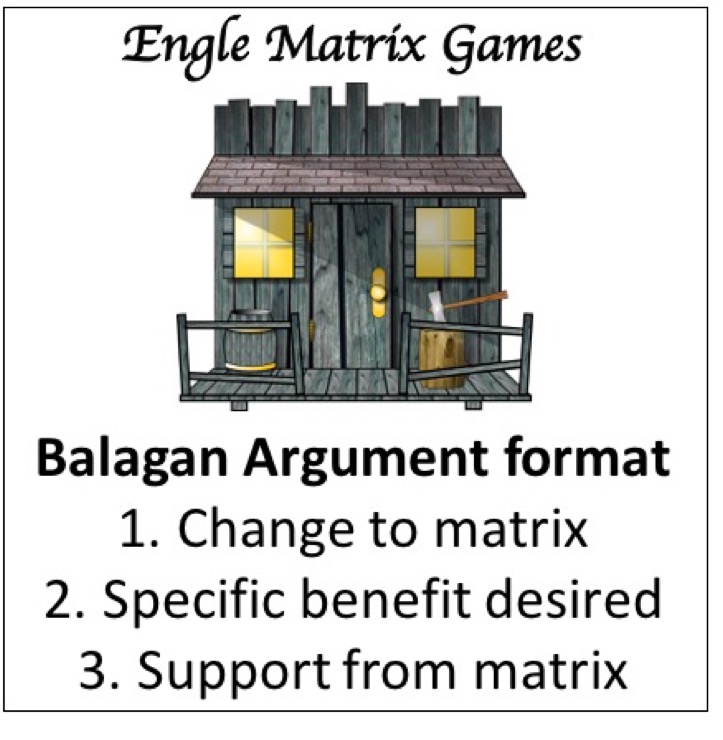It is easy to write bad arguments for Engle Matrix Games. I’ve decided to revert to something like the original argument format of “Action + Result + Reasons” to help the players get their arguments into the right shape. But those terms are ambiguous so I came up with my own format.
Because actions, results and reasons are a bit generic I’ve come up with three phrases: “Change to matrix”, “Specific benefit desired”, “Support from matrix”. The three phrases are used in combination to define the argument.
The way I look at Engle Matrix Games now, is that the “matrix” is the collective picture of the game world, aggregated from the initial umpire briefings, what players know about the context anyway, and previous successful arguments. Arguments should be explicit about how they are trying to change the matrix, even as an indirect benefit, and what in the matrix makes their argument stronger. [Note, originally the “matrix” was a set of key words to use in the argument; my definition is quite different.]
Change to matrix: A description of what happens, e.g. set up ambush, advance towards the enemy.
Specific benefit desired: How you expect to benefit in the game, e.g. gain tactical advantage or initiate an open battle. This is not guaranteed, it is a desire. Really it is just an opportunity for the player explicit about benefit they seek as a result of the change to the matrix.
Support from matrix: Evidence from the matrix supporting this argument; can be in the initial briefing or from a previously successful argument.
Asking the players to write their arguments in this format should help them focus on what they actually want to happen and why they think it should be successful.

Here are the two examples I traditionally use to illustrate arguments. They are from the Austerlitz Matrix Game. They are a bit stilted but convey the idea. By the way, the very original matrix was a set of phrases in a table, for example “Normal March”. You’ll see these in the examples. They align well with the three elements of the argument.
Example Argument:
Change to matrix: (Normal March) My army moves from France to Austria, via Wurttemburg and Bavaria.
Specific benefit desired: (Open Battle) We will fight the first army we encounter.
Support from matrix: (Prepare) The army is ready to go. (Supply Lines) Our supply lines are good. (Victory) I always win!
Example Argument:
Change to matrix: (Terrain ) I intend to reinforce the defences of the city.
Specific benefit desired: (Tactical Advantage) To make it harder to attack.
Support from matrix: (Love) I have the support of the population. (Fear) The enemy are threatening to attack at any moment. (Personal Ability) I have the engineering expertise needed.
When Chris and Nuno played my Missing General scenario they often only had the “Change to matrix” element. The “Specific benefit desired” was usually missing. And their “Support from matrix”, if present, were not necessarily grounded in the briefing or previous arguments. By splitting up these elements of the argument they would have known there was something missing. Here are a couple of examples based on the early arguments from the game, but with the missing elements:
German argument:
Change to matrix: I place platoon sized outposts on all three approach roads – then they dig in.
Specific benefit desired: I get early warning of approaching enemy.
Support from matrix: My troops are experienced. This is standard procedure when preparing for all round defence.
Soviet argument:
Change to matrix: My infantry battalions advance towards the Germans. The Ski battalion across country to the west and the my motorised and rifle battalions towards the village.
Specific benefit desired: To get in a position to engage the enemy.
Support from matrix: We are the advance guard and we will keep advancing despite adversity.
